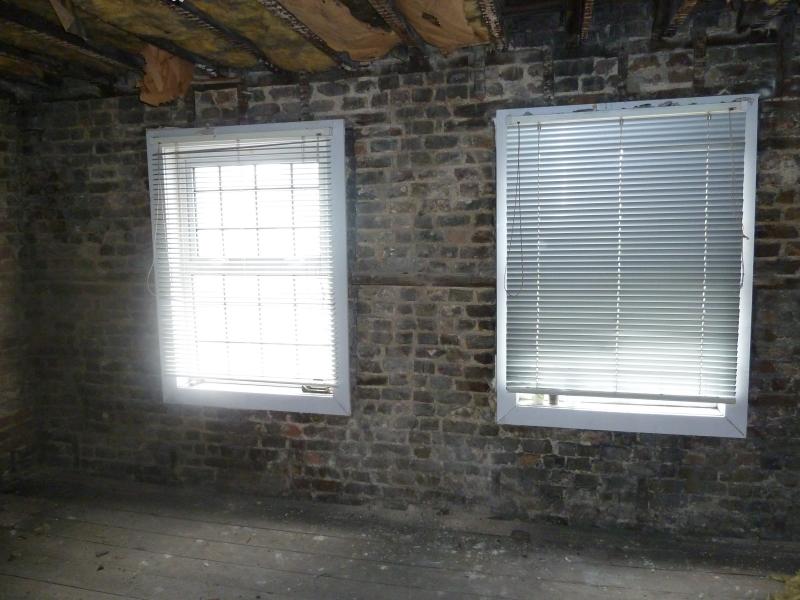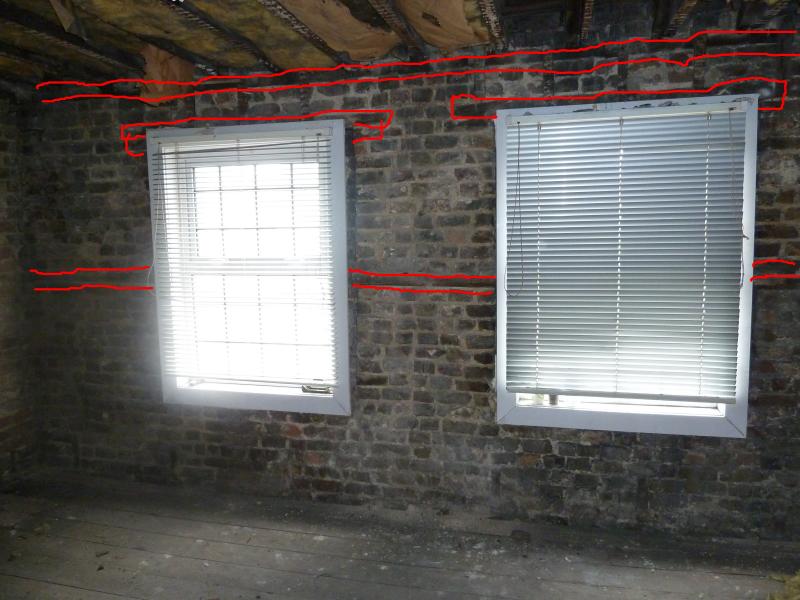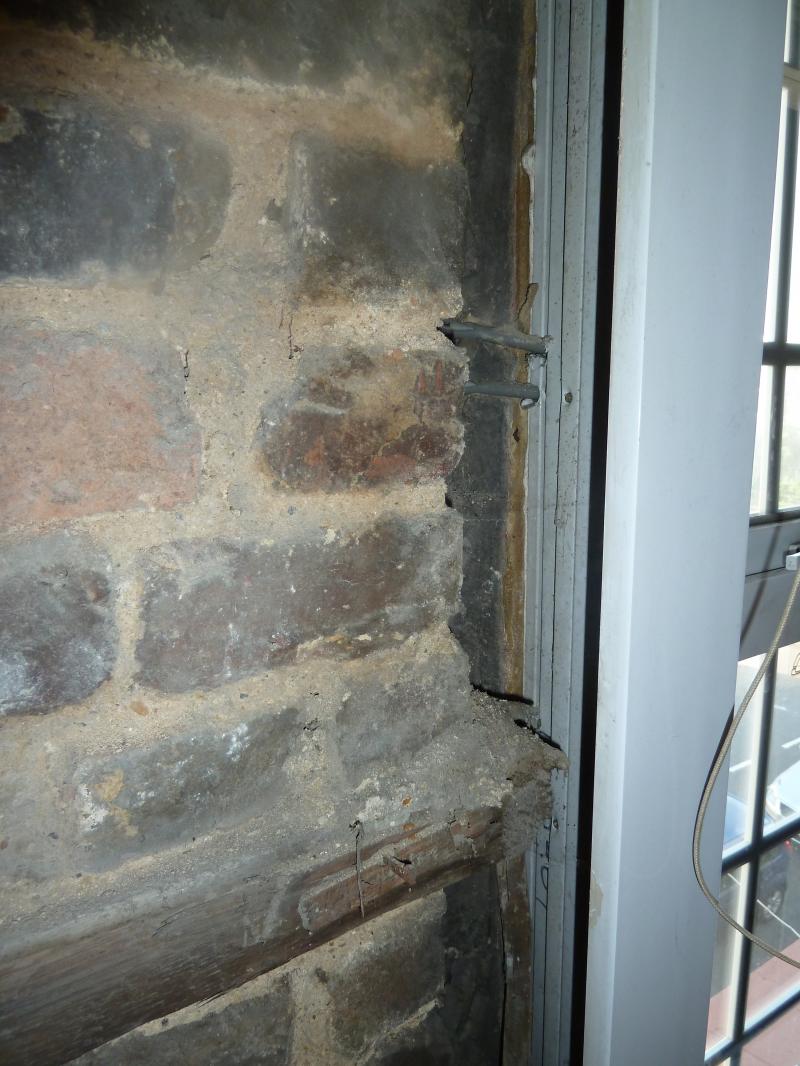Hi,
Last year we moved into a three storey Victorian terrace (built around 1840), with a parapet gutter at the front of the property.
The plaster work on the front room on the top floor was incomplete disrepair, and so we decided to take it down, go back to the brick and then completely re-plaster. Upon removing the plaster I found that one of the ceiling joists was rotten. I bought this up in a previous post, //www.diynot.com/forums/general-diy/broken-ceiling-joist.397572/#3063562 where you can see some photos of the rotten joist.
I thought it best to get a damp and timber surveyor in to have a look. I've now down this and it seems like there is a lot of work to do, and I would appreciate some advice on what to do next.
Here is an image of the front wall from the inside.
There is a lot of timber built into the wall, including the window lintels and the wall plate, where the rafters & joists meet the wall. There is also some timber built in around half way up the wall, which was used to fix timber battens to the wall for the laths. It is probably quite difficult to see in the photo, so I've highlighted the built in timber in this photo. (Well, I've tried to. My artwork leaves something to be desired)
The surveyors findings were
His suggested remedial work is as follows
At the end of the report he states that
When we moved in the rendering behind the down pipe on the front wall of the property was blown, and this was causing penetrating damp. This has now been rectified with new rendering.
The surveyor wasn't able to get up to the parapet gutter, so I don't know if this is an issue or not. As everything else in this house has had issues, I would suspect that it is an issue.
Anyway, I would appreciate some guidance on what to do next.
I was thinking of following the surveyors suggestion of building notice, and thereby getting advice on the structural issues from the LA. Is this a reasonable course of action? Should I submit it before or after I've found a builder? What are people's experiences with building notice and LA's?
I've had a look at building notice and full plans applications. It seems that building notice is mainly suitable for people who know what they are doing (in terms of building
regulations etc) which I don't.
I suppose the other alternative it to get a local structural engineer in myself, and get them to check whether the top of the front wall needs to be rebuilt. Do you think doing this, and going down the route of full plans application would be a better bet.
Sorry for the long post, but any advice would be appreciated.
Last year we moved into a three storey Victorian terrace (built around 1840), with a parapet gutter at the front of the property.
The plaster work on the front room on the top floor was incomplete disrepair, and so we decided to take it down, go back to the brick and then completely re-plaster. Upon removing the plaster I found that one of the ceiling joists was rotten. I bought this up in a previous post, //www.diynot.com/forums/general-diy/broken-ceiling-joist.397572/#3063562 where you can see some photos of the rotten joist.
I thought it best to get a damp and timber surveyor in to have a look. I've now down this and it seems like there is a lot of work to do, and I would appreciate some advice on what to do next.
Here is an image of the front wall from the inside.
There is a lot of timber built into the wall, including the window lintels and the wall plate, where the rafters & joists meet the wall. There is also some timber built in around half way up the wall, which was used to fix timber battens to the wall for the laths. It is probably quite difficult to see in the photo, so I've highlighted the built in timber in this photo. (Well, I've tried to. My artwork leaves something to be desired)
The surveyors findings were
A softwood wallplate is built into the front wall, and this supports the ceiling rafters and the roof rafters as well as parapet gutter boarding.
Several ceiling rafters were found to be loose/detached, and some suffering wood rot.
Counting from right hand end, the following rafters have problems as indicated :
No 4 : rafter too thin
No 7 : loose at end and rot damaged
No 8 : end of rafter rotten.
No 10 : end of rafter rotten
No 13 : end of rafter rotten
Easiest to simply replace defective rafters complete as timber not unduly expensive.
The built-in wallplate is subject to rot, mainly at its base, at a number of locations.
In addition, The left hand window’s timber lintel is rotten on the top, with wooden end
bearing pads rot affected, and the right hand window’s left hand timber bearing pad has rot underneath.
There are horizontal timbers at mid height of the windows, and these members are also
damaged by wood rot.
So in effect all built in timbers need replacement.
The parapet gutter boarding seemed in reasonable order where checked.
The two top floor windows are plastic double glazed sliding sash type.
They have been rather lazily fitted. There are huge voids between the original brick recesses and the new frames. This in effect in my opinion weakens the window openings, as a traditional box frame would help brace up and support a brick opening. Brickwork at this level has a noticeable bow and must in my opinion be tied in.
His suggested remedial work is as follows
Structural Assessment – Seek further advice from a local Structural Engineer who will probably agree with my suggestions for lateral restraint etc.
a) Floors – At very least - Additional bracing required.
b) Front Elevation bowing – Window openings need bracing up. You might opt, for example, to take out the two top floor windows and if finances allow – replace with traditional box frames.
c) Consider fitting elbow ties – say two, at each front wall corner. You can also use resin bonded steel helical ties ( EG by HELIFIX)
Note that some contractors would have re-built the top floor front wall due to the combination of defects.
Top Floor Timberwork
Replace complete the built in wallplate – ideally with dpc protection tacked to back and base. The wallplate can be fitted with ‘L’shaped strapes.
Replace defective or undersized ceiling joists (at least 4No)
Take out all embedded timber plates on front wall. Install two pre-cast concrete lintels.
Brick up timber built in bearers.
At the end of the report he states that
NOTE : In view of the range of structural repairs needed for the top floor – I advise you to obtain a building notice and liaise with the local authority building inspector – and by doing this you may obtain structural advice from the LA without needing to employ your own structural engineer. I have to advise you do this being a chartered surveyor with professional responsibilities. This case involves more than just dampness issues as you
can appreciate. I can’t be involved in site supervision due to the distances involved.
When we moved in the rendering behind the down pipe on the front wall of the property was blown, and this was causing penetrating damp. This has now been rectified with new rendering.
The surveyor wasn't able to get up to the parapet gutter, so I don't know if this is an issue or not. As everything else in this house has had issues, I would suspect that it is an issue.
Anyway, I would appreciate some guidance on what to do next.
I was thinking of following the surveyors suggestion of building notice, and thereby getting advice on the structural issues from the LA. Is this a reasonable course of action? Should I submit it before or after I've found a builder? What are people's experiences with building notice and LA's?
I've had a look at building notice and full plans applications. It seems that building notice is mainly suitable for people who know what they are doing (in terms of building
regulations etc) which I don't.
I suppose the other alternative it to get a local structural engineer in myself, and get them to check whether the top of the front wall needs to be rebuilt. Do you think doing this, and going down the route of full plans application would be a better bet.
Sorry for the long post, but any advice would be appreciated.




